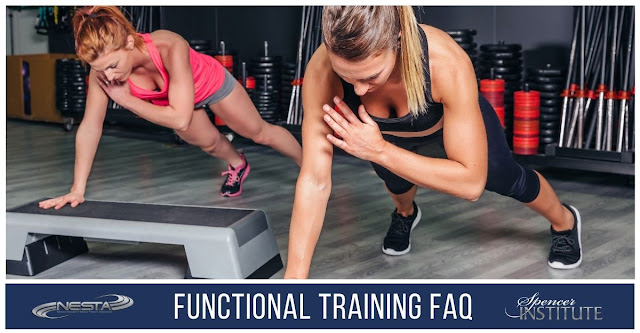Question 1: What is functional training?
Functional training is the utilization of exercises that involve complex, multi-joint movements of the upper body, core and lower body in each exercise. These movements enable greater overall bodily functioning and performance enhancement through improved coordination and the proper stimulation of muscular “firing” patterns.
Functional training is more than just training the body for “life” movements, it is preparing the body to be able to react and function better and more efficiently in any environment or situation.
Question 2: How is functional training different from bodybuilding?
Any individual who states that either “functional”, “bodybuilding”, or any other single format for exercise is the only or best way to train either does not understand the concepts of the various forms of training or is too close-minded to recognize new possibilities. Unfortunately, there are too many individuals who tout the benefits of one form of training over another without determining the true needs of the body as it coincides with the goals of the individual.
In other words, what is the body:
• Capable of doing?
• Meant to do?
A balance must be drawn between these two concepts. Too often choices are made based upon what an individual would like to do contrary to their current capabilities and overlooking what the body was meant to do. Just because the body CAN move in a given direction does not necessarily mean that it should be reinforced through repetitive movement patterns, with explosive tempo and heavy loads. We need more information before making these choices.
Functional training does not deny the benefits of traditional bodybuilding. Functional training does not deny the benefits of most theories of training. Training should be goal and individual specific. Many training programs sacrifice functionality and skip efforts to improve function to meet aesthetic goals. Whether the goal is aesthetics or performance, functionality will improve both. Traditional bodybuilding alone is simply not sufficient to enhance function and improve performance. There is only so much hypertrophy muscles can handle before function is impaired by overuse. The muscles surrounding the shoulder complex or glenohumeral joint are often very small and thin. With prolonged or excessive loading for building size or strength of the upper body, the shoulder can take quite a beating. Every movement involving the arms or upper torso affects the shoulders. Overuse or excessive heavy loading may create the visual effect of greater muscular size and an increased temporary ability to move heavy loads, but smaller muscles such as those of the rotator cuff (SITS – subscapularis, infraspinatus, teres minor, and supraspinatus) and scapular musculature (rhomboids and serratus anterior) were not meant to handle such loading.
When the damage done to connective tissue and overuse is observed many years later, it may be much more than a loss of muscular strength that occurs. Movement impairment is likely to occur due to overuse. Choosing an exercise or motion based purely upon feel is not an acceptable rationale. The body is intelligent and will accommodate most “requests” (such as heavy loading or excessively rapid movement while loaded or unloaded) regardless of whether this action is detrimental to the continued functioning of joints, muscles, and connective tissue.
The muscular system has a remarkable ability to dramatically and rapidly adapt to the imposed demands from almost any stimulus. In most cases, adaptations such as changes in strength or size are considered to be beneficial. However, such adaptations can also be detrimental and lead to impaired movement of the most mobile joints in the body such as the hips, shoulders, and spine. With great mobility, like that of the hips and shoulders, comes great instability. Therefore, excessive care must be taken in performing any movement utilizing the shoulders and hips to be certain that neither sustained postures or positions nor repeated or rapid movements over emphasize the surrounding muscles. Such improper postural positioning may be to the detriment of assistant movers (agonists), supporting (stabilizing) and antagonist muscles which protect and provide efficient movement of these joints. Variety in range and path of motion, speed of movement, direction of movement, loading, and muscular involvement are the keys to long term success. However, like anyone who has had long term success will tell you, a solid foundation is key. Functional training provides this foundation.
Question 3: Why is time spent on “function” so important if the main goal of most clients is weight loss and self-image and they don’t “have time” for function?
It is absolutely true that the main goal of most gym participants or fitness seekers is how they look more than “function”. Yet, function is undeniable in its ability to improve not only sport and daily work performance but physical appearance as well. Functional training should not deny the need for traditional weight lifting exercises. If function is not made a priority over the need to lift heavier weights and speed in movement, neither function nor physical appearance will reach their peak, and that will be the least of an individual’s problems.
Consider the example of an individual with rounded forward, protracted and elevated shoulders. Most trainers do not realize that both the triceps and biceps muscles have attachments at the scapula. When the shoulders round forward the biceps and tricep muscles become short and increasingly insufficient, or incapable of producing sufficient force due to shortening. This is a common occurrence with the result of the spinal extensors and shoulder flexors playing a greater role in the movement of load. This compensation is marked by swinging and “cheating”. Cheating is just cheating there is no functional benefit from it. Mass that is not functional is useless bulk. The muscles must obtain more than size. If the shoulders round forward during triceps and biceps exercises, these muscles will begin to lose their two joint functions at both the elbow and shoulder joint. This creates an increasingly unstable shoulder joint, and every muscle at the shoulder, including the biceps and triceps will suffer in development toward the pursuit of aesthetic and performance goals. Hypertrophy will still be gained, but muscles that become increasingly less involved due to poor postural positions while exercising will not benefit from these hypertrophic and strength gains.
The body will become used to compensating during movement and continue to provide extra support until the burden becomes too great and serious injury or impairment occurs. Laying the foundation with appropriate functional training will bring far greater results in the months and years down the road than can be achieved without it. In truth, it is not hard to see that functional training movements simply give greater depth and progression to movements already utilized in some form by most trainers and gym users.
Question 4: How does functional exercise fit into a regular exercise program?
Proper progression of functional before traditional exercise is crucial. (What does traditional exercise mean?) Functional exercises can be performed on a daily basis. There should be no significant hypertrophy from eccentric training, excessive speed of movement, or prolonged exercise duration from overly high numbers of sets or repetitions to prevent performing functional movements every day if designed properly. The most important factor is to include the appropriate variety of movement stresses and directions to avoid overuse or disuse at any particular joint. This does not mean choosing variety for its own sake. The goal of making every workout different just to be different is not a solid rationale. If the goal is to make every workout different while meeting the goals of the client, utilizing appropriate progression principles and techniques, such variety becomes a worthy choice. The ability to think on one’s feet and spontaneously produce an efficient, effective, progressive workout with variety takes both experience and considerable ability to apply knowledge gained. Thus is it is crucial for the functional training specialist to understand the physiology of joint movement.
It becomes all too easy for most trainers to train “muscles”, instead of “movements”. It was recently said in a major men’s fitness publication that “a well-defined six-pack is the ultimate signal to the rest of the world about your well-being. It says that you’re fit, you’re healthy, and you’re in control of your life and your body”. That is a pretty strong statement for some nice looking abs. There have been plenty of unhealthy people or people with problems, health or otherwise, who have the all encompassing and mighty six-pack. The fact is, most people who have “ripped” or “cut” abs probably chose their parents very well. In other words, genetics play a significant role. Most people who have sixpack abs have either killed themselves to get them (by abstaining from every pleasure known to mankind), have great genetics, or are athletes under the age of 25. Models and bodybuilders look that way because it’s their job. They live, eat and breathe aesthetics. Not to mention some rather questionable high-protein (more protein than anything else which is great for looking shredded but not for health) diet plans, thermogenic aids, diuretics, and perhaps a little help from tanning. These people have worked hard for years. Results, like they have obtained, do not come overnight and do not come without a price.
Question 5: Who is this functional training specialist program for?
This is a foundational program for trainers and clients of all levels. It will provide a solid foundation in promoting joint and muscle stability, mobility and strength endurance as a basis for speed and power development for any individual who needs these benefits. In our experience, that is just about everyone.
Question 6: How can you “overload” muscles using functional training?
The concepts of fatigue, overload and progression are often either abused or misunderstood. No one is to blame, we all simply need to remain open minded and seek to gain as much information and benefit as possible from any training principle or form of training. The need to progress appropriately is undeniable. Overload may come from variability in loading, tempo, direction of movement, range of motion, recovery times, time under tension, and intensity. The common belief about overloading a muscle is that it must come from increased weight or the ability to move more weight. Overload is “increased stress” to a muscle or muscle group and comes in many forms. Just as any phase or form of training, the capability to handle overload is individual and goal specific. Overload is about increasing stress through change in the FITTR variables. This means any variation or change that increases stress by changing the frequency of exercise, intensity (volume), time under tension, type of exercise, and the rate of progression. That is overload. An exercise may either overload one muscle or the entire system (kinetic chain). It should be obvious, but many gym-goers and trainers alike insist upon following exercise principle interpretations and theories because someone else told them or it “worked for them”. Making decisions based upon such “hearsay” would not get you anywhere in the fields of medicine, law or with the IRS. Unfortunately, it is no different with fitness. It is possible to get lucky with a new gimmick for training that may work for some individuals. But if the basis for exercise programming is not based on a recognition of how the body moves (kinesiology) and the forces (kinetics) that act upon it, the potential for disaster is extremely high. There are many ways of reaching most goals.
There is never or rarely only one solution. Appropriate training accomplishes goals with minimal risk in the quickest amount of time. This is the goal of functional training. We are too often guilty of seeing the end goal without acknowledging the path. Rarely is the path to our goals an easy one.
The beginning of progressive exercise must begin with appropriate assessment. Without this, how can you know where to start?
Read the rest here

